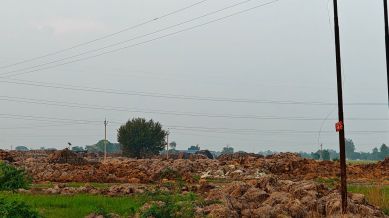Stay updated with the latest - Click here to follow us on Instagram
Punjab’s sand paradox: Glut in fields, boom in riverbed
Desilting race begins, but quality, valuation and data gaps raise questions

The floodwaters have left Punjab with a paradox. Vast stretches of farmland are buried under cheap sand that farmers are struggling to clear, even as the state’s riverbeds hold sand officially valued at hundreds of crores.
Water Resources Minister Barinder Kumar Goyal says riverbeds along the Sutlej and Ravi contain an estimated 190 crore cubic feet of sand, valued at Rs 840 crore. But the calculation behind this figure remains unclear. Market prices currently vary widely, from Rs 1 per cubic foot in inundated villages to Rs 32 to 40 per cubic foot in areas unaffected by flooding. How the government arrived at a uniform valuation of Rs 4.42 per cubic foot has not been explained.
monthly limit of free stories.
with an Express account.
The floods also exposed inconsistencies in river-flow data. The Ravi touched a record 14.11 lakh cusecs in late August, against a safe capacity of 60,000 to 1 lakh cusecs. At Yusufpur in Jalandhar, the flow reached 1.64 lakh cusecs. The Sutlej rose to 2.8 to 3.0 lakh cusecs near Ismailpur, but before reaching the Harike barrage, the flow was recorded at 1.64 lakh cusecs, a sharp drop that officials have not yet accounted for.
Desilting has now become a priority. The Cabinet led by Chief Minister Bhagwant Mann has reduced tender processing time from 21 to 14 days and cleared 85 desilting sites on the Sutlej and Ravi. Officials say this will increase carrying capacity by 1 lakh cusec, taking it from 2.5 lakh to 3.5 lakh cusecs, though they have not specified which river this increase refers to.
The Beas remains off-limits because it falls within a Ramsar-designated wetland and forest reserve. Goyal attributes the delay to the previous Congress government and says the state will now request central clearance for desilting.
On farmland, the focus is immediate restoration. IIT Ropar has been asked to assess the depth and spread of silt deposits, but officials say this is only for documentation and is not linked to compensation or future reclamation policy.
In inundated belts, farmers are depending on one another for labour and machinery. “We pool tractors and earthmovers. One farmer alone cannot handle this volume,” says Bikram Singh from Majha. Much of the deposited sand is of low construction quality. “It is mostly fit for earth filling or tiles,” says Faridkot trader Rakesh Grover. Clean, coarse sand for construction remains scarce in non-affected regions.
Under the state’s “Jisda Khet, Usda Ret” policy, farmers are allowed to remove and sell sand from their own fields until December 31. However, the policy does not spell out safeguards against soil erosion or nutrient loss. It also remains unclear whether river desilting will depress prices further, affecting farmers who are already selling sand at distress rates simply to prepare for Rabi sowing.
As Punjab begins to dig out, the question ahead is not just about sand. It is about the gaps in data, valuation and planning that the floods have laid bare.